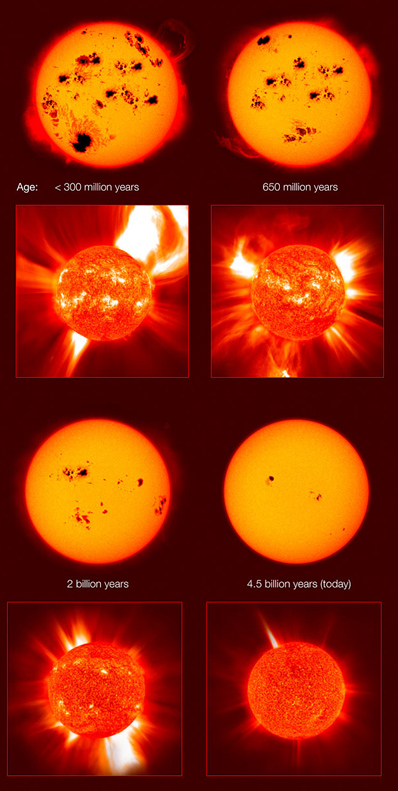
The Sun's excessive youth
KEITH COOPER
ASTRONOMY NOW
Posted: August 11, 2009


In its youth our Sun span ten times faster, with a much more powerful magnetic field and enormous sunspots covering it like vast continents on a planet, according to a meeting of minds at the Solar and Stellar Variability symposium at the International Astronomical Union’s General Assembly in Rio de Janeiro. As a result, it turns out that the Sun and Earth may not be the best locations for life in the Universe after all.
 Magnetic activity on our Sun has declined over billions of years as its rate of rotation has slowed. Image: IAU/E Guinan.
Magnetic activity on our Sun has declined over billions of years as its rate of rotation has slowed. Image: IAU/E Guinan.
By looking at other stars that are analogues of our own Sun at different ages, a team led by Professor Edward Guinan of Villanova University, USA, was able to piece together the stages of the Sun’s history. They found that four billion years ago it took our Sun less than three days to make one revolution. This dizzying pace would have had the magnetic dynamo inside the Sun working overtime, creating a much more powerful magnetic field than the Sun possesses today. Enormous sunspots, which are magnetically driven, will have plagued its surface and the X-ray and ultraviolet radiation emitted would have been hundreds of times stronger than today – not a terribly comforting environment for life to get a foothold in. Not until two and a half billion years ago would there have been enough oxygen in Earth’s atmosphere to create an ozone layer to protect from the ultraviolet light emitted by the Sun. Prior to that, the radiation will have had a profound affect on burgeoning life by forcing mutations in its DNA.
“The ultraviolet and cosmic-ray environment around a star may very well have ‘chosen’ what type of life could arise around it,” says Manfred Cuntz of the University of Texas at Arlington, USA.
To this end, Guinan’s team speculate that our Sun isn’t really the best type of star for life to develop on planets around it. “Our studies indicate that the ideal stars to support planets suitable for life for tens of billions of years may be a smaller, slower burning orange dwarf with a longer lifetime than the Sun – about 20–40 billion years,” he says. “These stars, also called K-stars, are stable stars with a habitable zone that remains in the same place for tens of billions of years.”
These orange dwarfs are also ten times more common in the Universe, but Cuntz offers a word of caution. “The most significant damage [to biological systems] associated with ultraviolet light occurs from UV-C [short-wave ultraviolet], which is produced in enormous quantities in the photosphere of hotter F-type stars and further out, in the chromospheres, of cooler K-type and red M-type stars.”
For comparison, our Sun is a G-type star. The most habitable planets around these stars therefore may be ‘superearths’ several times more massive than our planet, with stronger gravity for retaining an atmosphere, and a more powerful magnetic field to protect against the ultraviolet onslaught, particularly when the star is young.
Nevertheless, Guinan is more than happy with the way things turned out here on Earth. “I would not trade [our Sun] – you can’t argue with success.”
|



